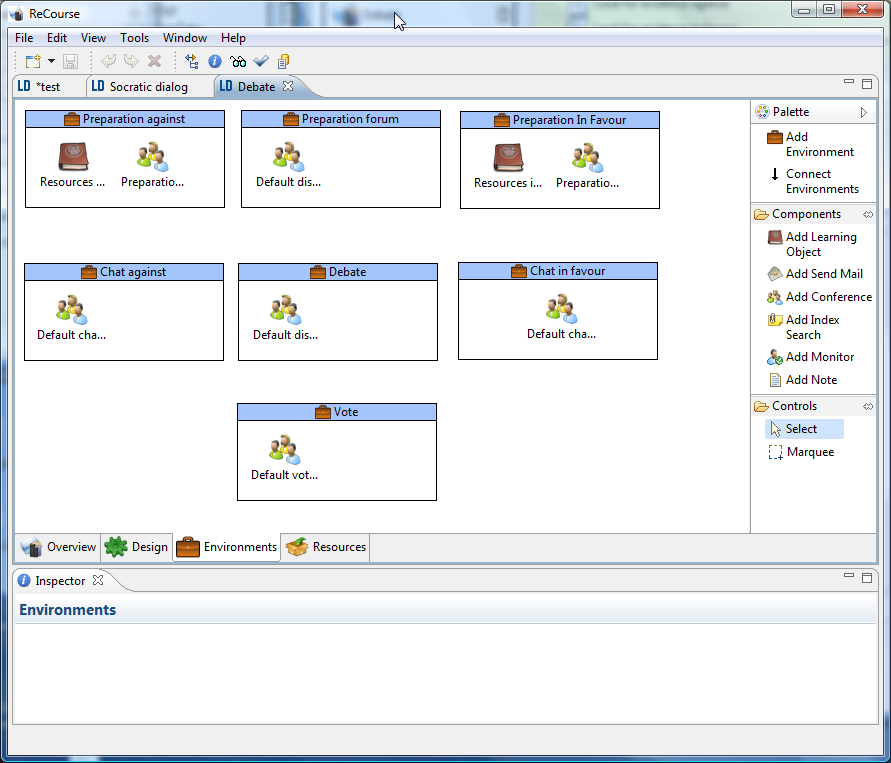ReCourse editor: Difference between revisions
m (→Links) |
m (Text replacement - "<pageby nominor="false" comments="false"/>" to "<!-- <pageby nominor="false" comments="false"/> -->") |
||
| (3 intermediate revisions by the same user not shown) | |||
| Line 1: | Line 1: | ||
{{Stub}} | {{Stub}} | ||
<pageby nominor="false" comments="false"/> | <!-- <pageby nominor="false" comments="false"/> --> | ||
== Definition == | == Definition == | ||
ReCourse is a [[IMS Learning Design]] editor | ReCourse is a [[IMS Learning Design]] editor that was sponsored by the TENCompetence project. As of April 2014, The latest version is 2.0.3 and was released 1st February 2010. Like all (most?) IMS LD projects, it feels like a dead project.... | ||
{{quotation|ReCourse is a tool to create [[IMS Learning Design]] compliant Units of Learning. It is free, open source, cross-platform and extensible. It was developed as part of the European-funded TENCompetence project. IMS Learning Design is extensive and complex, and there are very few effective and easy to use tools available which teachers can use to produce Units of Learning which are compliant with the specification. TENCompetence has developed ReCourse to provide learning designers with a solution.}} ([http://tencompetence-project.bolton.ac.uk/ldauthor/ home page], retrieved Apr. 2014. | |||
This editor is implemented with Eclipse, needs Java installed on your computer and should run on all platforms. Users should be familiar with the IMS learning design language, i.e. understand its logic and the purpose of its most important elements. | This editor is implemented with Eclipse, needs Java installed on your computer and should run on all platforms. Users should be familiar with the IMS learning design language, i.e. understand its logic and the purpose of its most important elements. | ||
See also: | |||
* [[Prolix graphical learning modeller]] (and its fork OpenGLM) | |||
== The user interface == | == The user interface == | ||
| Line 18: | Line 23: | ||
== Links == | == Links == | ||
* [http://www.tencompetence.org/ldauthor/ | * [http://tencompetence-project.bolton.ac.uk/ldauthor/ ReCourse Learning Design Editor] (ok as of april 2014) | ||
* [http://www.tencompetence.org/ldauthor/ old project page], '''dead link'''). This page also did include a manual | |||
[[Category: XML]] | [[Category: XML]] | ||
Latest revision as of 18:18, 22 August 2016
Definition
ReCourse is a IMS Learning Design editor that was sponsored by the TENCompetence project. As of April 2014, The latest version is 2.0.3 and was released 1st February 2010. Like all (most?) IMS LD projects, it feels like a dead project....
“ReCourse is a tool to create IMS Learning Design compliant Units of Learning. It is free, open source, cross-platform and extensible. It was developed as part of the European-funded TENCompetence project. IMS Learning Design is extensive and complex, and there are very few effective and easy to use tools available which teachers can use to produce Units of Learning which are compliant with the specification. TENCompetence has developed ReCourse to provide learning designers with a solution.” (home page, retrieved Apr. 2014.
This editor is implemented with Eclipse, needs Java installed on your computer and should run on all platforms. Users should be familiar with the IMS learning design language, i.e. understand its logic and the purpose of its most important elements.
See also:
- Prolix graphical learning modeller (and its fork OpenGLM)
The user interface
The user inteface is a mixture between what could be called the Reload paradigm (load level forms-editing) and a visual educational design language editor.
Here are two screendumps from a included "dialog scenario" that was included in the download of version 1.7.1.
Links
- ReCourse Learning Design Editor (ok as of april 2014)
- old project page, dead link). This page also did include a manual
Bibliograph
- Griffiths, D. et al. (2009) From Reload to ReCourse: learning from IMS Learning Design implementations. Distance Education, Vol 30, No. 2, pp. 201 – 222

